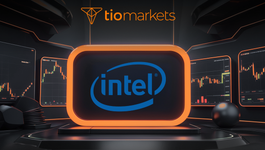Nikkei 225 Index: What It Is and How to Trade It | TIOmarkets
BY TIOmarkets
|June 11, 2024The Nikkei 225 Index, a beacon for investors and traders worldwide, represents a crucial segment of the financial market. This article delves into the essence of the Nikkei 225, its significance, and the avenues available for trading it. With a focus on providing a comprehensive understanding, we aim to equip you with the knowledge to navigate this aspect of the financial world effectively.
Understanding the Nikkei 225 Index
The Nikkei 225, often referred to as the Nikkei Stock Average, is a premier stock market index for the Tokyo Stock Exchange (TSE). It serves as a barometer for the overall health of the Japanese economy and the Asian market at large. Let's break down its components and significance.
History and Composition
The Nikkei 225 was first introduced in 1950, and since then, it has become a critical measure of market activity. Comprising 225 of the top publicly traded companies in Japan, it covers a wide range of industries, from electronics to automotive, ensuring a comprehensive snapshot of the corporate landscape.
These companies are selected based on their market capitalization and liquidity, making the Nikkei 225 a reliable indicator of market trends and economic health in Japan.
Significance of the Nikkei 225
The index's broad coverage across sectors makes it an essential tool for investors looking to understand market dynamics in Japan. Its movements are closely watched by financial professionals and policymakers alike as it reflects the impact of economic policies, global events, and market sentiment on the Japanese economy.
Moreover, the Nikkei 225's performance is often seen as a precursor to market trends in other Asian economies, highlighting its importance beyond Japan's borders.
How to Trade the Nikkei 225
Trading the Nikkei 225 offers investors a gateway to the Japanese market, providing opportunities for diversification and exposure to one of the world's largest economies. Here are the primary methods to trade this index.
Direct Investment in Stocks
One approach to trading the Nikkei 225 is by directly investing in the stocks of the companies that comprise the index. This method allows investors to focus on specific sectors or companies they believe will outperform the market.
However, it requires a deep understanding of the Japanese market and the ability to analyze individual stocks, making it more suitable for experienced investors.
Exchange-Traded Funds (ETFs) and Mutual Funds
For those seeking broader exposure, Exchange-Traded Funds (ETFs) and mutual funds that track the Nikkei 225 offer a more accessible option. These funds replicate the index's performance, providing investors with a diversified portfolio of the top Japanese companies.
This method simplifies the investment process, making it an attractive option for both novice and seasoned investors looking to tap into the Japanese market.
Derivatives and Futures Contracts
Investors interested in leveraging their positions or hedging against market volatility might consider derivatives and futures contracts based on the Nikkei 225. These financial instruments allow traders to speculate on the future direction of the index without holding the underlying assets.
While offering the potential for significant returns, these methods also carry a higher level of risk and require a solid understanding of the derivatives market.
Risks and Considerations
Trading the Nikkei 225, like any investment, involves certain risks and requires careful consideration. Here are some key factors to keep in mind.
Market Volatility
The Japanese market, influenced by both domestic and international events, can experience significant volatility. Investors should be prepared for fluctuations in the Nikkei 225 and consider strategies to mitigate risk, such as diversification and setting stop-loss orders.
Economic and Political Factors
Economic policies, political stability, and global events can all impact the performance of the Nikkei 225. Staying informed about these factors is crucial for making informed trading decisions.
Currency Risk
For international investors, changes in the exchange rate between their home currency and the Japanese yen can affect returns. Considering currency risk and employing strategies to hedge against it can be beneficial.
Trading Strategies for the Nikkei 225
Developing a sound trading strategy is essential when engaging with the Nikkei 225. Here are some popular approaches that traders often consider:
Technical Analysis
Many traders rely on technical analysis to forecast price movements in the Nikkei 225. By studying historical price charts and using indicators like moving averages and relative strength index (RSI), traders aim to identify trends and make informed trading decisions.
Fundamental Analysis
Another common strategy is fundamental analysis, where traders evaluate the financial health and performance of companies within the Nikkei 225. By analyzing factors such as earnings reports, economic data, and industry trends, traders seek to determine the intrinsic value of stocks and make trading decisions based on this information.
Market Sentiment Analysis
Market sentiment analysis involves gauging the overall mood of investors and traders towards the Nikkei 225. By monitoring news headlines, social media trends, and market reports, traders can assess whether the market is bullish or bearish, helping them make contrarian or trend-following trading decisions.
Impact of Global Events on the Nikkei 225
The Nikkei 225 is not immune to the influence of global events, which can have a significant impact on its performance. Here are some examples of global events that can affect the Nikkei 225:
Trade Wars
Trade tensions between major economies, such as the US and China, can lead to market uncertainty and affect the Nikkei 225. Tariffs, trade agreements, and geopolitical disputes can all impact investor confidence and the overall performance of the index.
Geopolitical Events
Geopolitical events, such as conflicts, natural disasters, and political instability, can create volatility in the financial markets, including the Nikkei 225. Traders often monitor geopolitical developments closely to assess their potential impact on market sentiment and stock prices.
Global Economic Indicators
Key economic indicators from major economies, such as GDP growth rates, employment data, and inflation figures, can influence the Nikkei 225. Positive or negative economic reports can drive market movements and impact investor decisions in the Japanese market.
Conclusion
The Nikkei 225 Index offers a window into the Japanese economy and provides a range of opportunities for traders and investors. Whether through direct stock investments, ETFs, mutual funds, or derivatives, engaging with the Nikkei 225 requires an understanding of the market dynamics and a strategic approach to risk management. By staying informed and considering the various avenues for trading, investors can navigate the complexities of the Japanese market and potentially capitalize on its movements.
Start Trading the Nikkei 225 with TIOmarkets
Ready to explore the Japanese markets and trade the Nikkei 225? TIOmarkets, a top-rated forex broker, offers you the platform to trade over 300 instruments across 5 markets, including indices like the Nikkei 225. With low fees and a global presence in over 170 countries, we provide you with the tools and educational resources to trade effectively. Take the first step towards mastering the financial markets by creating your trading account today and join our community of 170,000+ traders!

Risk disclaimer: CFDs are complex instruments and come with a high risk of losing money rapidly due to leverage. You should consider whether you understand how CFDs work and whether you can afford to take the high risk of losing your money. Never deposit more than you are prepared to lose. Professional client’s losses can exceed their deposit. Please see our risk warning policy and seek independent professional advice if you do not fully understand. This information is not directed or intended for distribution to or use by residents of certain countries/jurisdictions including, but not limited to, USA & OFAC. The Company holds the right to alter the aforementioned list of countries at its own discretion.
Join us on social media

Behind every blog post lies the combined experience of the people working at TIOmarkets. We are a team of dedicated industry professionals and financial markets enthusiasts committed to providing you with trading education and financial markets commentary. Our goal is to help empower you with the knowledge you need to trade in the markets effectively.
Related Posts





